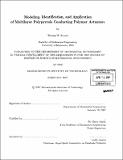Modeling, identification, and application of multilayer polypyrrole conducting polymer actuators
Author(s)
Secord, Thomas W. (Thomas William)
DownloadFull printable version (12.01Mb)
Other Contributors
Massachusetts Institute of Technology. Dept. of Mechanical Engineering.
Advisor
H. Harry Asada.
Terms of use
Metadata
Show full item recordAbstract
Experiments were performed using commercially available, self-contained, multilayer polypyrrole (PPy) actuators to develop low-order lumped parameter models of actuator electrical, mechanical, and electromechanical behavior. Experimental data were processed using system identification techniques. Both grey box and black box models were identified. The grey box model consisted of a first order electrical network that was linearly and algebraically coupled to a second order viscoelastic model. The black box model incorporated a third order Box-Jenkins structure and achieved model to data residues comparable to the grey box model. When utilizing validation data, the grey box model showed very good performance for loads in the range of 0.5 to 3 N. Overall, the results of system identification experiments suggested that low order, lumped parameter models were adequate to describe the gross behavior of multilayer actuators. An online identification scheme was developed for monitoring polymer electrical impedance and thereby monitoring the degradation state of an actuator. This identification was performed successfully using recursive least squares and least squares for a discrete impedance model. (cont.) Experimental validation data, spanning more than 5 hours of continuous operation, were collected and analyzed. A final contribution of this research was the application PPy linear actuators to a custom-designed humanoid foot. Four linear conducting polymer actuators were used to obtain multifunctional behavior of the overall foot. Jacobian analysis of stiffness and damping was performed for the design. Simulations illustrated that PPy actuators through the use of appropriate electrical excitation can modulate their stiffness characteristics as a function of time to match a desired force versus length relationship.
Description
Thesis (S.M.)--Massachusetts Institute of Technology, Dept. of Mechanical Engineering, 2007. Includes bibliographical references.
Date issued
2007Department
Massachusetts Institute of Technology. Department of Mechanical EngineeringPublisher
Massachusetts Institute of Technology
Keywords
Mechanical Engineering.